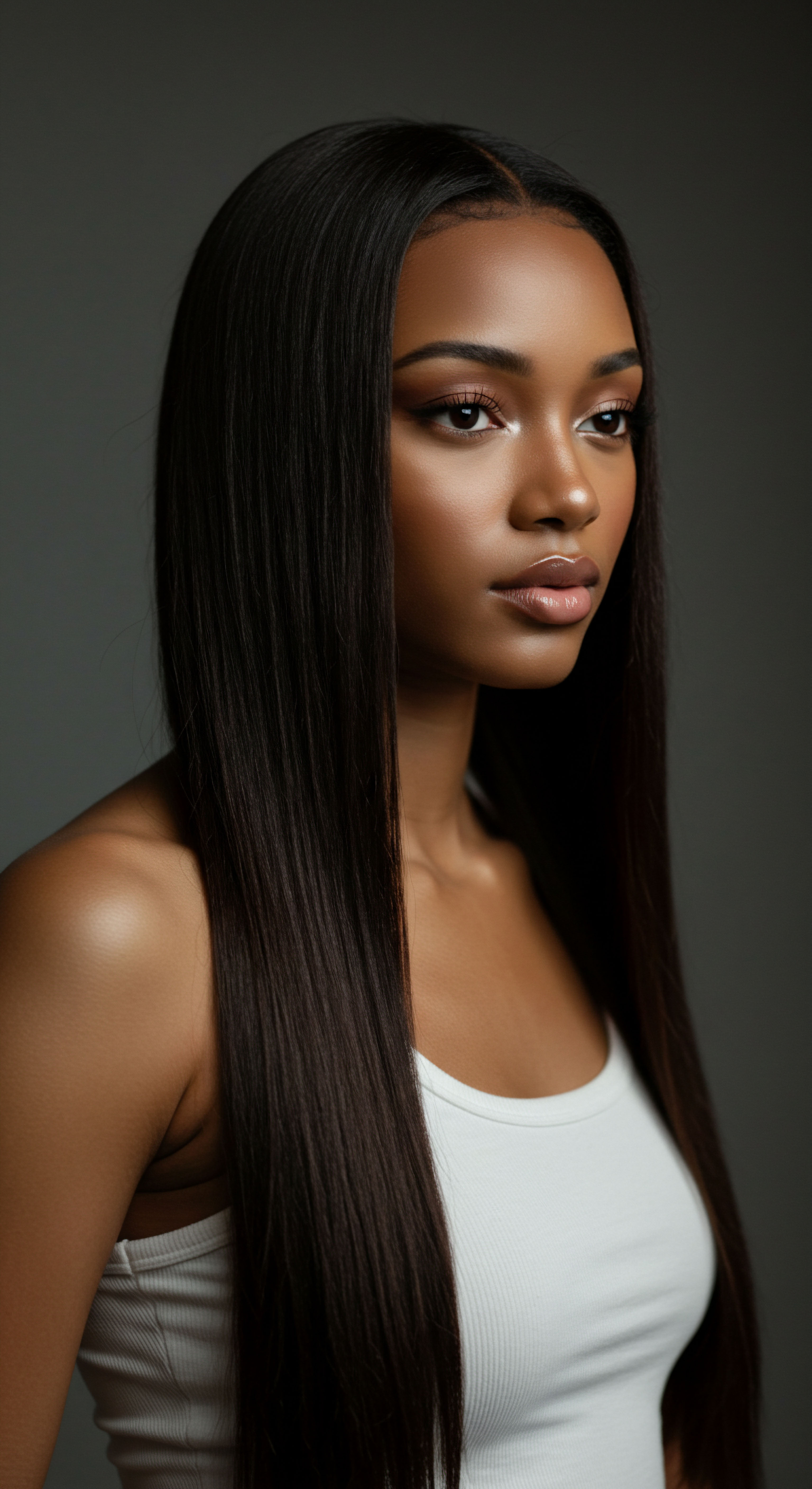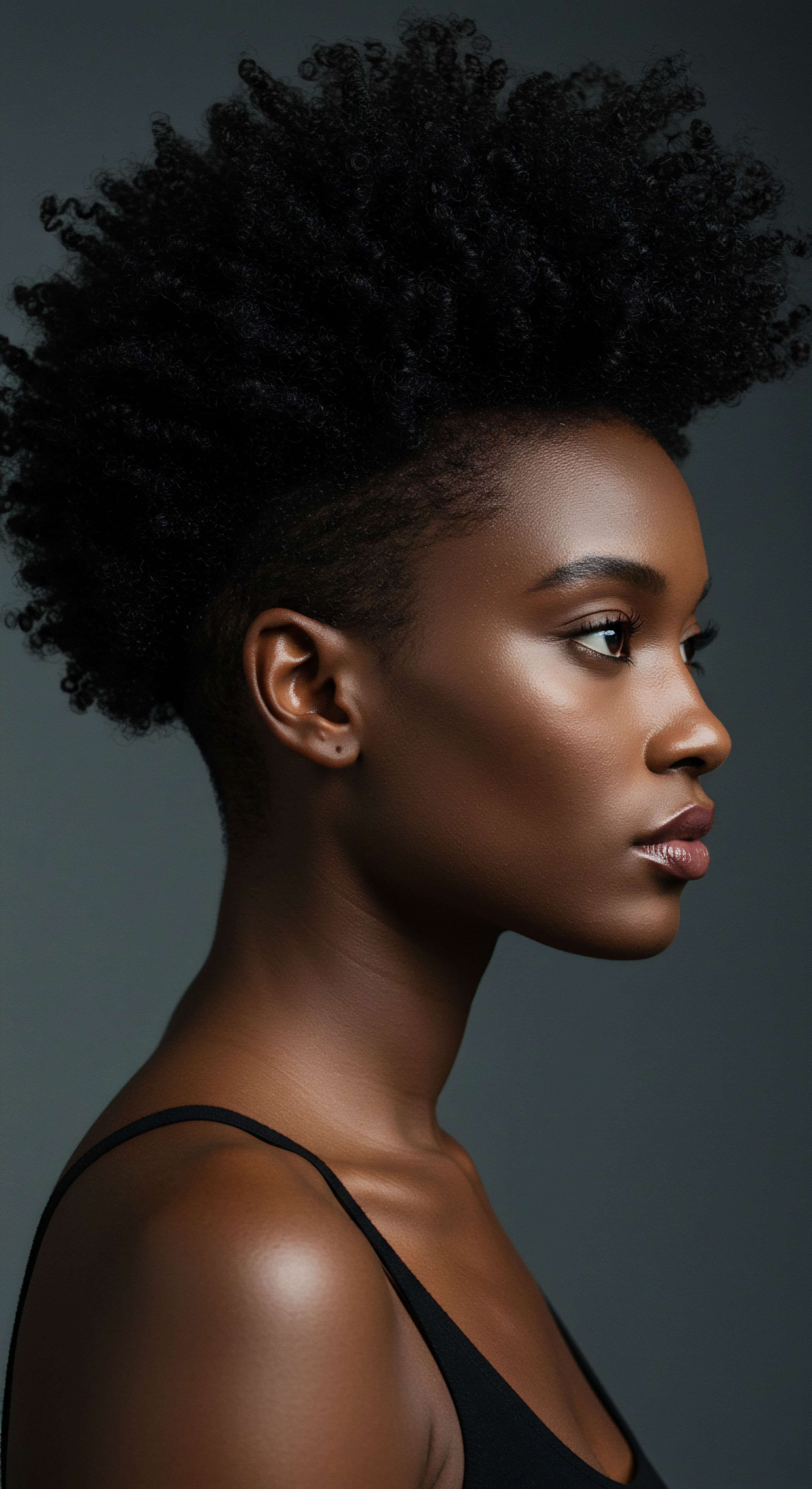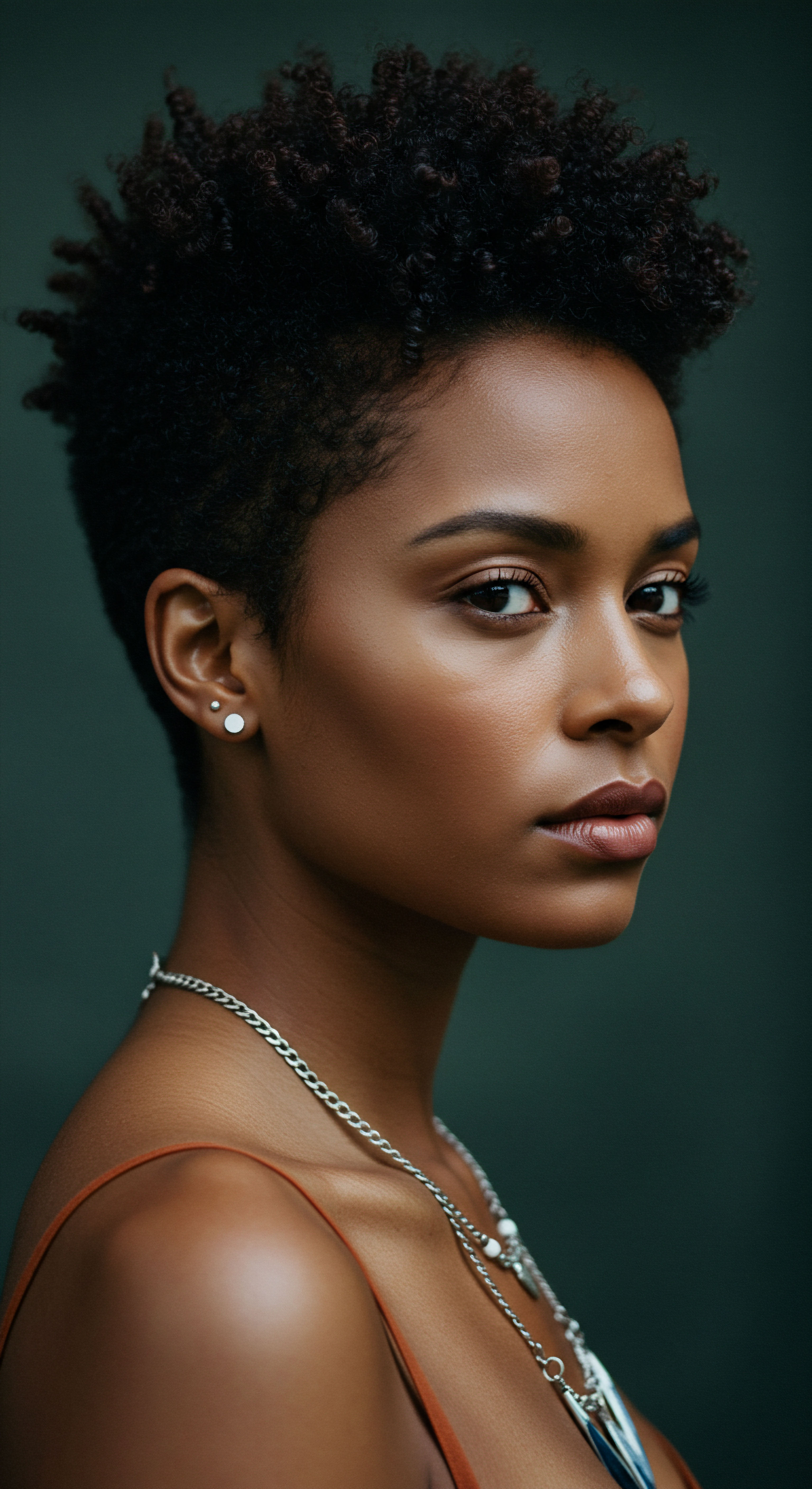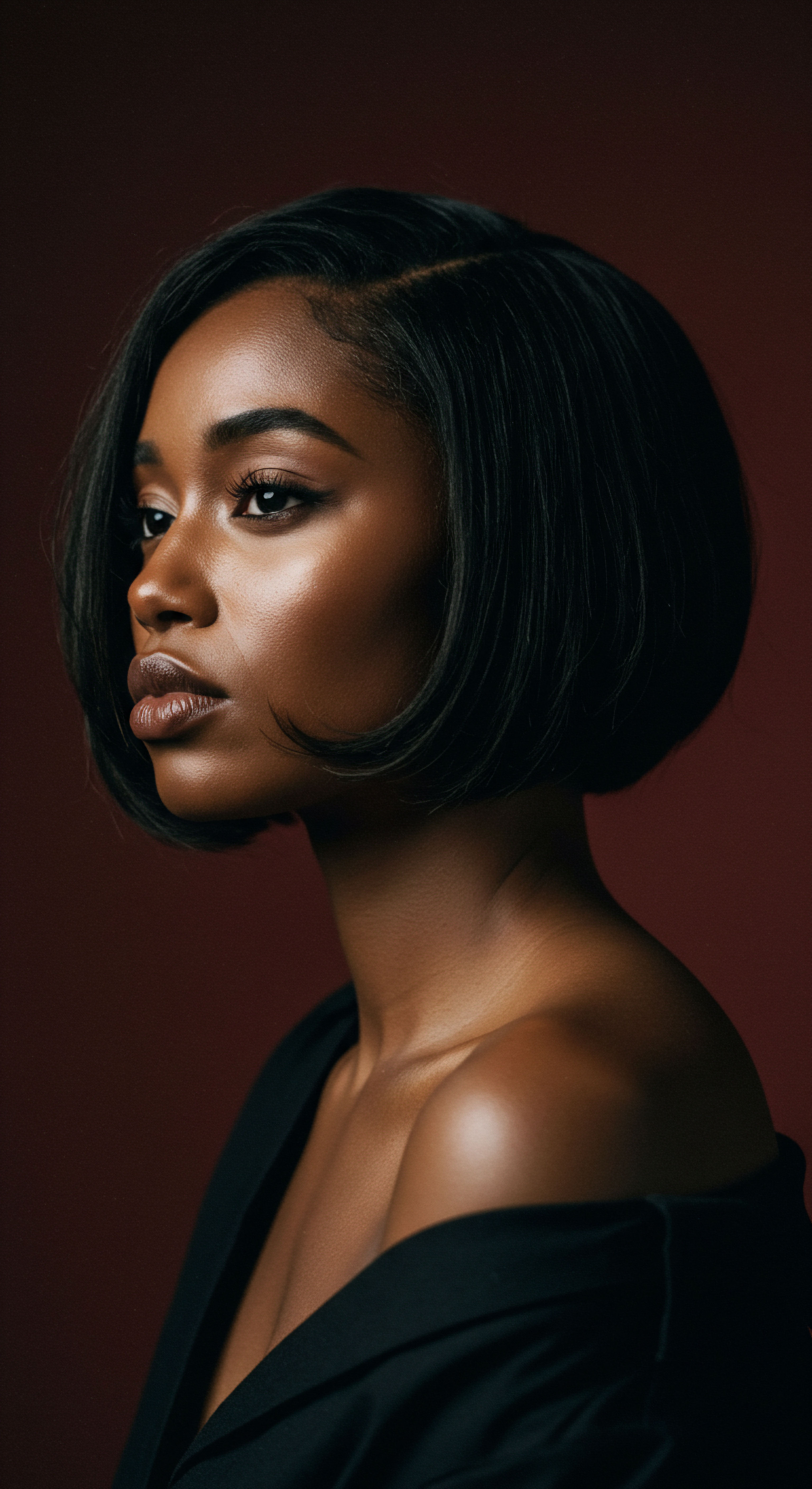
Roots
Consider the delicate balance of moisture within a single strand of hair, particularly textured hair, which often possesses a unique architectural arrangement. At the core, our hair, much like the vibrant plant life that seeks sustenance from the earth, thirsts for hydration. This fundamental need becomes especially pronounced during our hours of repose, a time when our bodies undergo a quiet renewal. Yet, in this period of rest, hair can inadvertently surrender its precious water to the surrounding environment, a phenomenon often overlooked in the daily rhythm of care.
The outermost layer of each hair strand, the cuticle, resembles tiny, overlapping scales. When healthy and smooth, these scales lie flat, creating a protective barrier that seals in moisture and reflects light, giving hair its characteristic luster. However, this protective shield is susceptible to disturbance. Friction, a constant companion of movement, particularly during sleep, can lift, chip, or even break these delicate scales.
Such disruption leaves the inner hair shaft exposed, allowing moisture to escape more readily into the air. For textured hair, with its inherent curves and coils, the points of contact with surfaces multiply, potentially increasing the friction and subsequent cuticle disruption.
This inherent vulnerability to moisture loss, compounded by mechanical forces during sleep, presents a quiet challenge. Understanding the microscopic reality of our strands helps illuminate why thoughtful consideration of our nighttime surroundings becomes a gentle yet powerful act of preservation for hair’s well-being.
The hair’s outermost layer, the cuticle, is a protective shield, and its integrity is vital for maintaining internal moisture.

Hair’s Delicate Structure and Moisture Balance
Each hair strand is a marvel of biological engineering, comprised of three primary layers ❉ the medulla, cortex, and cuticle. The Medulla, the innermost core, is not always present in finer hair types. Surrounding it is the Cortex, the primary determinant of hair’s strength, elasticity, and color, holding the majority of its moisture.
The outermost layer, the Cuticle, serves as the first line of defense against environmental stressors and mechanical damage. When the cuticle is healthy, its scales lie flat, creating a smooth surface that helps retain moisture and minimize friction.
For textured hair, the helical structure of the strand means the cuticle scales do not always lie as flat as they might on straight hair. This natural inclination can make textured hair more susceptible to moisture loss and physical damage from external forces. The gaps or raised areas in the cuticle allow water molecules to exit the hair shaft more easily, leading to dryness, brittleness, and a greater propensity for breakage. Maintaining a healthy moisture balance is not simply about adding water, but about ensuring the cuticle remains sealed enough to hold that water within the cortex.

How Environmental Factors Strip Moisture
The air around us, particularly in dry climates or temperature-controlled environments, actively seeks moisture. This natural process, known as transepidermal water loss (TEWL) when referring to skin, applies to hair as well. As we sleep, especially in a low-humidity room, the surrounding air acts as a sponge, drawing hydration away from our hair. This evaporative process, while subtle, can lead to significant dryness overnight, leaving hair feeling parched and brittle upon waking.
Beyond environmental humidity, the materials our hair rests upon contribute significantly to moisture loss. Absorbent fabrics, such as many common cotton pillowcases, readily soak up the natural oils and any applied conditioning products from our hair. This absorption means that instead of remaining on the hair shaft to condition and protect, moisture is transferred to the fabric, leaving hair drier and more vulnerable to damage. The combined effect of environmental evaporation and material absorption creates a nightly challenge for hair hydration.

Ritual
As the quiet hours descend, a thoughtful practice of protection for our hair becomes a serene ritual, a gentle acknowledgment of its unique needs. The shift from day to night invites us to consider how our surroundings can either deplete or preserve the vitality of our strands. This understanding guides us toward simple yet impactful customs that safeguard hair’s moisture and structural integrity.
The choices we make for our sleep environment, particularly the materials that cradle our hair, profoundly shape its morning disposition. Let us step into a space of shared wisdom, where techniques and tools are explored with gentle guidance, illuminating paths to healthier hair through the night.
The choice of sleep covering stands as a quiet yet powerful decision in the nightly care regimen for textured hair. Historically, and in contemporary practice, various materials have been employed to shield hair from the rigors of sleep. The primary goal remains consistent ❉ to minimize friction and prevent the absorption of hair’s inherent moisture or applied products. The difference in materials, from traditional cotton to luxurious silk and satin, directly influences how effectively this protection is achieved.

Ancient Practices and Modern Innovations
The practice of covering hair during sleep is not a recent discovery; it is a tradition with roots stretching back centuries across various cultures. From the intricate headwraps of African communities, often serving as symbols of status and identity while offering practical protection, to the delicate silk coverings used in Asian traditions, the wisdom of preserving hair overnight has been passed down through generations. These coverings, whether simple or ornate, shared a common purpose ❉ to maintain hairstyles, prevent tangles, and protect hair from environmental elements and mechanical wear.
In modern times, this ancient wisdom finds its expression in the widespread use of satin bonnets and silk pillowcases. These contemporary coverings, while sometimes stripped of their deeper cultural symbolism for broader consumer markets, retain the fundamental protective qualities. They represent an evolution in materials, leveraging textile science to achieve optimal hair preservation during sleep.

Why Does Material Matter for Hair Moisture?
The impact of a sleep covering on hair moisture levels hinges on the material’s surface properties and its absorbency.
- Cotton ❉ A widely used fabric, cotton is known for its breathability and comfort. However, its natural fibers possess a rough, uneven surface when viewed microscopically. As hair rubs against cotton during sleep, this textured surface creates friction, which can lift the hair’s cuticle scales. This mechanical stress leads to frizz, tangles, and eventually, breakage. Furthermore, cotton is highly absorbent, readily drawing moisture from hair and skin. This means that any natural oils or hydrating products applied before bed are likely to be absorbed by the pillowcase, leaving hair dry and prone to damage.
- Satin ❉ Often mistaken for silk, satin is a weave, not a fiber. Typically made from polyester, nylon, or rayon, satin’s smooth, glossy surface provides significantly less friction than cotton. This reduced friction helps to keep the hair cuticle smooth and intact, minimizing frizz and tangles. While satin is less absorbent than cotton, it can still draw some moisture from hair, though considerably less than its cotton counterpart. Its affordability makes it a popular choice for bonnets and pillowcases among those seeking hair protection.
- Silk ❉ A natural protein fiber, silk is renowned for its exceptionally smooth surface and minimal absorbency. The amino acid structure of silk fibers allows hair to glide across its surface with very little friction, preserving the hair cuticle and preventing breakage. Moreover, silk’s low absorbency means it does not strip hair of its natural moisture or applied products. This allows conditioners, oils, and leave-in treatments to remain on the hair, working to hydrate and protect throughout the night. Silk also helps to regulate temperature, contributing to a comfortable sleep environment.
The table below illustrates the comparative effects of common sleep covering materials on hair:
| Material Cotton |
| Surface Texture Rough, fibrous |
| Friction Level High |
| Moisture Absorbency High |
| Impact on Hair Cuticle Lifts, abrades, causes frizz and breakage |
| Material Satin (Polyester) |
| Surface Texture Smooth, synthetic |
| Friction Level Low |
| Moisture Absorbency Moderate |
| Impact on Hair Cuticle Minimizes lifting, reduces frizz |
| Material Silk |
| Surface Texture Very smooth, natural protein |
| Friction Level Very Low |
| Moisture Absorbency Very Low |
| Impact on Hair Cuticle Preserves integrity, prevents damage |
| Material Choosing a sleep covering with low friction and low absorbency can greatly improve hair health overnight. |
The choice of sleep covering material profoundly influences hair’s nightly experience, with smooth, less absorbent options offering greater protection.

Which Sleep Covering is Best for Hair Moisture?
For those seeking to maintain hair moisture and reduce mechanical damage, the consensus points towards silk and satin. While both offer significant advantages over cotton, their mechanisms differ slightly. Satin, being a synthetic weave, provides a smooth surface that allows hair to glide without snagging, reducing frizz and tangles. It is a cost-effective alternative that delivers noticeable benefits.
Silk, however, stands as the premier choice. As a natural protein fiber, its smooth surface is inherently gentle on hair, minimizing friction to an exceptional degree. More importantly, silk’s unique structure means it is less absorbent than cotton or even many satins. This characteristic ensures that the moisture within your hair, whether natural or from applied products, remains where it belongs ❉ on your strands.
This superior moisture retention is particularly beneficial for textured hair, which tends to be more prone to dryness. The consistent use of silk or satin coverings, whether as a bonnet or a pillowcase, can lead to visibly softer, more hydrated, and less damaged hair over time.

Relay
Beyond the tangible touch of a silk bonnet or the smooth glide of a satin pillowcase, what deeper currents of science and heritage truly guide their influence on our hair as we sleep? The answer extends beyond simple friction and absorption, inviting us to consider the intricate dance between hair’s molecular architecture, the subtle forces of our environment, and the profound wisdom passed down through generations. This exploration asks us to peer closer, to appreciate the unseen dynamics at play, and to recognize that hair protection during rest is a sophisticated interplay of biology, physics, and cultural practice. Let us journey into this rich intersection, where data meets tradition, revealing a profound understanding of hair’s nightly preservation.
The impact of sleep coverings on hair moisture is a multi-layered phenomenon, rooted in the biophysics of hair and the dynamics of material interaction. To truly grasp how these coverings preserve hydration, we must delve into the microscopic world of the hair shaft and consider the subtle, yet powerful, forces at play during our hours of slumber.

How Does Hair Exchange Moisture with Its Surroundings?
Hair, much like our skin, is constantly exchanging water with its environment. This process is governed by principles of thermodynamics and vapor pressure. When the air around hair is drier than the hair itself, water molecules move from the hair into the air. This natural evaporative loss is amplified by environmental conditions such as low humidity, often found in heated or air-conditioned bedrooms.
This is a manifestation of Transepidermal Water Loss (TEWL), a term more commonly applied to skin, but whose principles extend to the hair shaft’s interaction with its surroundings. Studies indicate that water loss from the skin and hair can increase significantly during sleep, partly due to the body’s circadian rhythm influencing skin temperature and pH, which in turn promote water evaporation.
The material of a sleep covering acts as a microclimate modifier. A smooth, non-absorbent material creates a barrier, reducing the direct exposure of hair to dry air and minimizing the rate of water evaporation. It also prevents the material itself from acting as a wick, drawing moisture away from the hair. This protective effect helps maintain a more stable, hydrated environment around the hair strands, allowing the hair’s natural moisture balance to remain undisturbed.

The Unseen Enemy of Hair Health Friction
While moisture absorption is a significant factor, the mechanical stress induced by friction is equally, if not more, detrimental to hair health and its ability to retain moisture. Hair cuticles, when subjected to repeated rubbing against rough surfaces, lift and chip. This damage compromises the hair’s natural barrier, creating pathways for moisture to escape and making the hair more susceptible to external aggressors.
Research on the tribological properties of hair, which studies friction and wear, highlights the importance of surface smoothness. A study titled “Frictional Effects in Human Hair” by Schwartz & Knowles (1963) was among the first to detail how friction from combing and contact with various materials can wear down the hair cuticle. More recent work, such as “Friction Dynamics of Straight, Curly, and Wavy Hair” by Bhushan et al.
(2014), further illustrates that wavy or curly hair, due to its geometry, experiences more points of contact and is thus more prone to friction-induced damage. The average person shifts position up to 40 times each night, creating repeated instances of friction between hair and pillowcase.
Interestingly, some studies have explored the electrostatic charge generated by textile friction. A paper on “Electric Static Charge Generated from the Sliding of Head Scarf Textiles against Skin and Hair” by El-Messiry et al. (2017) linked static to increased friction and further cuticle damage, particularly in polyester-based textiles. However, a controversial finding from a study on textile fabrics and hair growth in dogs (El-Messiry et al.
2008, published in PubMed) reported that polyester material generated electrostatic potentials that seemed to inhibit hair growth, whereas cotton and woolen textiles did not. The study posited that friction between the polyester textile and the skin created an ‘electrostatic field’ responsible for the inhibited hair growth. While this research was conducted on canines and focused on growth rather than moisture retention, it presents a thought-provoking, less commonly discussed aspect of textile-hair interaction, suggesting that the subtle electrical charges generated by certain synthetic fabrics might have implications beyond mere physical friction, potentially influencing the very environment of the hair follicle. This opens a line of inquiry into whether similar electrostatic phenomena could subtly affect moisture equilibrium or scalp health in humans, a realm still awaiting more comprehensive human-centric investigation.
A comparison of friction coefficients between various textiles and hair further underscores the advantage of smooth materials. Silk, with its remarkably low coefficient of friction, allows hair to glide with minimal resistance, thereby preserving the cuticle’s integrity. Cotton, conversely, exhibits a higher friction coefficient, leading to greater mechanical stress on the hair shaft.
Beyond direct moisture loss, the unseen friction from sleep coverings can significantly compromise hair’s protective cuticle, leading to dehydration and breakage.

The Cultural Context of Nighttime Hair Protection
The practice of protecting hair during sleep is not solely a matter of scientific understanding; it is deeply rooted in cultural practices and heritage, particularly within Black communities. For generations, head coverings like bonnets and scarves have served as essential tools for preserving intricate hairstyles, maintaining moisture, and safeguarding hair from damage. This tradition emerged from both practical necessity and a profound respect for hair as a symbol of identity, beauty, and resilience.
During periods of enslavement in the United States, Black women often used rudimentary coverings crafted from scraps of fabric to protect their hair from harsh conditions and to maintain its health amidst limited resources. As time progressed, these coverings evolved, becoming expressions of personal style and cultural pride, worn both indoors and outdoors. The hair bonnet, in particular, became synonymous with “bedtime beauty,” a conscious act of preserving natural texture and preventing tangles and frizz. This rich history underscores that the use of sleep coverings is not merely a modern beauty trend but a continuation of ancestral wisdom, a testament to the enduring importance of hair care as a ritual of self-preservation and cultural affirmation.
The cultural significance of hair protection extends beyond the practical. In many African traditions, headwraps, known by names like ‘Dukus’ in Ghana or ‘Geles’ in Nigeria, have conveyed social status, marital standing, and even emotional states. While forced to wear head coverings as a symbol of subservience during certain historical periods, Black women reclaimed these items, transforming them into symbols of creative and cultural expression. This historical context adds a layer of depth to the modern practice, revealing it as a continuation of a legacy of care, resistance, and self-definition.

Reflection
As the quiet hours of night draw to a close, and the first hints of dawn appear, the subtle choices we make for our hair during sleep reverberate through the morning. It is a testament to the profound connection between our daily rituals and the vitality of our being. The consideration of a sleep covering, whether a silken embrace or a satin shield, transcends a mere act of beauty; it becomes a gentle dialogue with our heritage, a quiet act of scientific understanding, and a loving commitment to the strands that tell our story. May this nightly care bring forth a deeper appreciation for the delicate strength and enduring beauty of textured hair, allowing it to greet each new day with renewed moisture and serene grace.

References
- Schwartz, A. M. & Knowles, D. C. (1963). Frictional Effects in Human Hair. Journal of the Society of Cosmetic Chemists, 14, 463-472.
- Bhushan, B. et al. (2014). Friction Dynamics of Straight, Curly, and Wavy Hair. Journal of Applied Physics, 115(2), 024303.
- El-Messiry, M. et al. (2017). Electric Static Charge Generated from the Sliding of Head Scarf Textiles against Skin and Hair. Journal of Textile Engineering & Fashion Technology, 1(5).
- Bouillon, C. & Wilkinson, J. (Eds.). (2005). The Science of Hair Care (1st ed.). CRC Press.
- Zviak, C. (1986). The Science of Hair Care (1st ed.). CRC Press.
- Davis-Sivasothy, A. (2011). The Science of Black Hair ❉ A Comprehensive Guide to Textured Hair Care. Sivasothy Hair Publishing.
- El-Messiry, M. et al. (2008). Polyester but not cotton or wool textiles inhibit hair growth. PubMed.
- Bouillon, C. & Wilkinson, J. (Eds.). (2005). Hair Structure, Function, and Physicochemical Properties. In The Science of Hair Care (1st ed.). CRC Press.
- Bhushan, B. & Haddad, P. (2005). Friction and wear studies of human hair and skin. Wear, 259(7-12), 1012-1021.
- El-Messiry, M. & Ibrahim, M. (2018). A Study on the Electrostatic Charge Generated From the Friction of Wig Cap Textiles against Human Skin and Hair. ResearchGate.